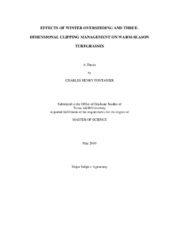| dc.description.abstract | Perennial ryegrass (Lolium perenne L.) is commonly overseeded into hybrid
bermudagrass [Cynodon dactylon (L.) Pers. X C. transvaalensis Burtt Davy] turfs during autumn
in the southern United States. Overseeding can provide a green, actively-growing turf
throughout the winter dormancy period. Improved persistence of perennial ryegrass cultivars has
increased management inputs during the spring transition period. Lower input turf systems that
provide acceptable winter overseeding quality are preferred, and research aimed at evaluating
alternative overseeding species are warranted. Grooming reel attachments allowing for threedimensional
clipping management (3DCM) have become increasingly used by turf managers for
reducing grain and thatch, but scientific information on best management practices and canopy
effects of 3DCM-grooming are lacking. A field study was conducted at the Texas A&M
Turfgrass Field Laboratory in College Station, TX (30.6191 degrees N, 96.3576 degrees W), to investigate the
effects of overseeding using annual (Lolium multiflorum Lam.) and perennial ryegrasses on
3DCM-groomed and non-groomed fairway turfs of 'Tifway' hybrid bermudagrass, zoysiagrass
[Zoysia matrella (L.) Merr. 'Cavalier'], and seashore paspalum (Paspalum vaginatum Sw. 'Sea
Isle 1'). The study was arranged as a randomized complete block split-split-plot with three replications. Species whole main plots were split into three grooming intervals, which were
further split into four overseeding treatments. Data were collected assessing visual turf quality,
visual turf cover, leaf area index, clipping yield, shoot density, and biomass partitioning.
Results indicate annual ryegrass alone and an annual/perennial ryegrass overseeding mix
provided acceptable turf quality, but did not improve turf recovery over perennial ryegrass alone
in 'Tifway' or 'Sea Isle 1' turfs. In 'Cavalier' turfs, summer quality was affected by overseeding
treatment as follows: control > annual > annual/perennial > perennial. The overseeding
tolerance of the warm-season turfgrasses was as follows: 'Sea Isle 1' > 'Tifway' > 'Cavalier'.
Differences in canopy architecture of warm-season turfgrasses were related to the overseeding
tolerance of each species and used to explain plant competition during the spring transition
period. Grooming by 3DCM improved late-season turf quality and reduced scalping in 'Tifway'.
Overseeding establishment and canopy architecture were not affected by 3DCM. | en |


